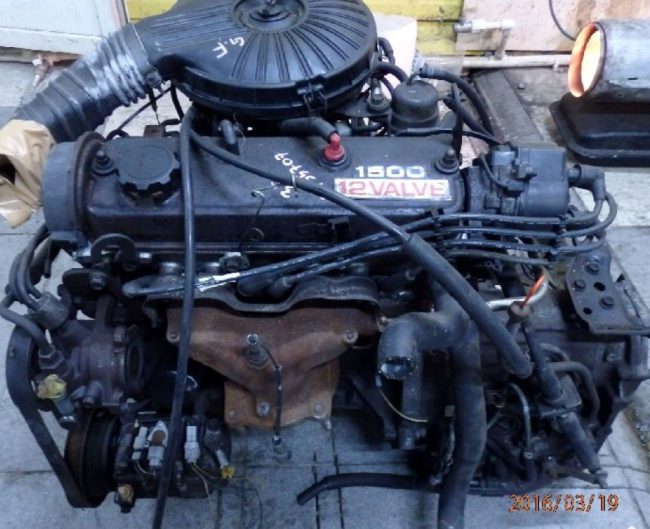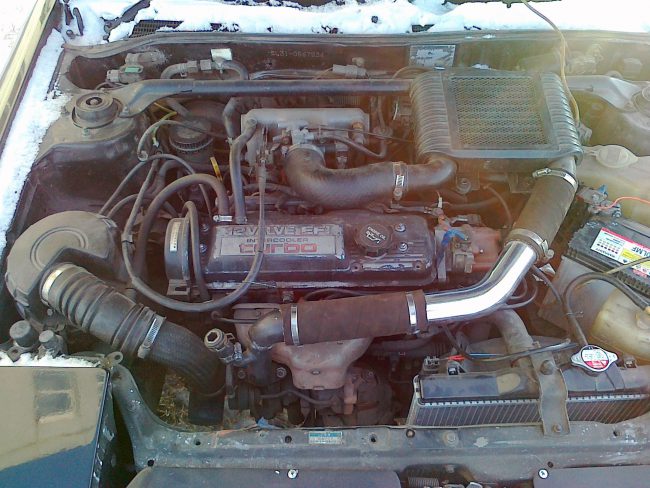
Toyota 3E, 3E-E, 3E-T, 3E-TE engines
Content
The 3E series has become the third stage in the modernization of small engines of Toyota Motor Corporation. The first motor saw the light in 1986. The 3E series in various modifications was produced until 1994, and was installed on the following Toyota cars:
- Tersel, Corolla II, Corsa EL31;
- Starlet EP 71;
- Crown ET176 (VAN);
- Sprinter, Corolla (Van, Wagon).

Each subsequent generation of the car became larger and heavier than its predecessor, which required increased power. The working volume of the 3E series engines was increased to 1,5 liters. by installing another crankshaft. The configuration of the block turned out with long-stroke pistons, where the stroke significantly exceeds the cylinder diameter.
How a 3E motor works
This ICE is a carbureted transversely mounted power unit with four cylinders arranged in a row. The compression ratio, compared with its predecessor, decreased slightly, and amounted to 9,3: 1. The power of this version reached 78 hp. at 6 rpm.

The material of the cylinder block is cast iron. As before, a number of measures have been taken to lighten the engine. Among them are a cylinder head made of aluminum alloy, a lightweight crankshaft, and others.
The aluminum head has 3 valves per cylinder, one camshaft, according to the SOHC scheme.
The design of the motor is still quite simple. There are no various tricks for that time in the form of variable valve timing, hydraulic valve clearance compensators. Accordingly, the valves need regular clearance checks and adjustments. The carburetor was responsible for supplying the air-fuel mixture to the cylinders. There are no fundamental differences from such a device on the previous series of motors, the difference is only in the diameter of the jets. Accordingly, the carburetor turned out to be generally reliable, but remained difficult to adjust. Only an experienced master can properly set it up. The ignition system completely migrated from the 2E carburetor unit without any changes. This is electronic ignition paired with a mechanical distributor. The system still annoyed owners with intermittent misfiring in the cylinders due to its malfunctions.
Stages of modernization of the motor 3E
In 1986, a few months after the start of production of the 3E, a new version of the 3E-E engine was launched into the series. In this version, the carburetor was replaced by distributed electronic fuel injection. Along the way, it was necessary to modernize the intake tract, ignition system and electrical equipment of cars. The measures taken have had a positive effect. The motor got rid of the need for periodic adjustment of the carburetor and engine failures due to ignition system errors. Engine power in the new version was 88 hp. at 6000 rpm. Motors produced between 1991 and 1993 were derated to 82 hp. The 3E-E unit is considered the least expensive to maintain if you use high-quality fuels and lubricants.
In 1986, almost in parallel with the injector, turbocharging began to be installed on 3E-TE engines. The installation of the turbine required a reduction in the compression ratio to 8,0:1, otherwise the operation of the engine under load was accompanied by detonation. The motor produced 115 hp. at 5600 rpm The maximum power revolutions have been reduced to reduce thermal loads on the cylinder block. The turbo engine was installed on Toyota Corolla 2, also known as Toyota Tercel.

Advantages and disadvantages of 3E motors
Structurally, the 3rd series of small-capacity Toyota engines repeats the first and second, differences in engine displacement. Accordingly, all the pros and cons were inherited. ICE 3E are considered the most short-lived of all Toyota gasoline engines. The mileage of these power plants before overhaul rarely exceeds 300 thousand km. Turbo engines do not go more than 200 thousand km. This is due to the high thermal load of the motors.
The main advantage of the 3E series motors is ease of maintenance and unpretentiousness. Carburetor versions are insensitive to the quality of gasoline, injection ones are a little more critical. Attracts high maintainability, low prices for spare parts. The 3E power plants got rid of the biggest drawback of their predecessors - a broken cylinder head gasket at the slightest overheating of the engine. This does not apply to version 3E-TE. Significant disadvantages include:
- Short-lived valve seals. This leads to splattering of candles with oil, increased smoke. Service departments offer to immediately replace the original valve stem seals with more reliable silicone ones.
- Excessive carbon deposits on intake valves.
- The occurrence of piston rings after 100 thousand kilometers.
All this leads to a loss of power, unstable operation of the internal combustion engine, but it is treated without great expense.
Technical specifications
The 3E series motors had the following technical characteristics:
| Engine | 3E | 3E-E | 3E-TE |
|---|---|---|---|
| Number and arrangement of cylinders | 4, in a row | 4, in a row | 4, in a row |
| Working volume, cm³ | 1456 | 1456 | 1456 |
| Supply system | carburetor | injector | injector |
| Maximum power, hp | 78 | 88 | 115 |
| Maximum torque, Nm | 118 | 125 | 160 |
| Block head | aluminum | aluminum | aluminum |
| Cylinder diameter, mm | 73 | 73 | 73 |
| The piston stroke, mm | 87 | 87 | 87 |
| Compression ratio | 9,3:1 | 9,3:1 | 8,0:1 |
| Gas distribution mechanism | SOHC | SOHC | SOHC |
| number of valves | 12 | 12 | 12 |
| Hydraulic compensators | no | no | no |
| Timing drive | belt | belt | belt |
| Phase regulators | no | no | no |
| Turbocharging | no | no | Yes |
| Recommended oil | 5W – 30 | 5W – 30 | 5W – 30 |
| Oil volume, l. | 3,2 | 3,2 | 3,2 |
| fuel type | AI-92 | AI-92 | AI-92 |
| Environmental class | EURO 0 | EURO 2 | EURO 2 |
| Approximate resource, thousand km | 250 | 250 | 210 |
The 3E series of power plants enjoyed a reputation for being reliable, unpretentious, but short-lived motors prone to overheating under high loads. The motors are simple in design, they do not have any complex features, so they were popular with motorists due to their ease of maintenance and high maintainability.
For those who prefer contract engines, the offer is quite large, finding a working engine will not be very difficult. But the residual resource will most often be small due to the large age of the power plants.

